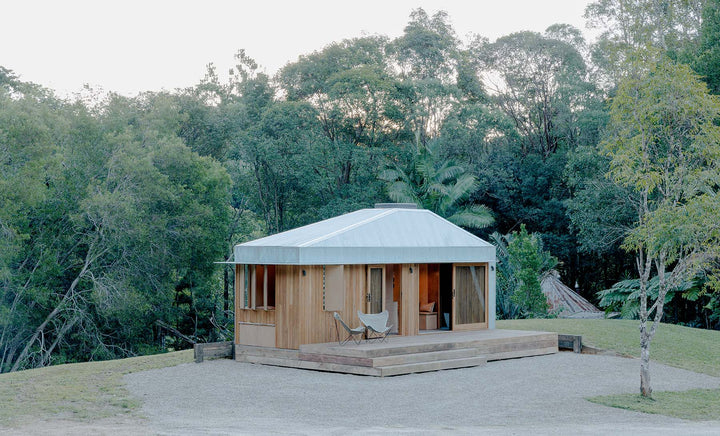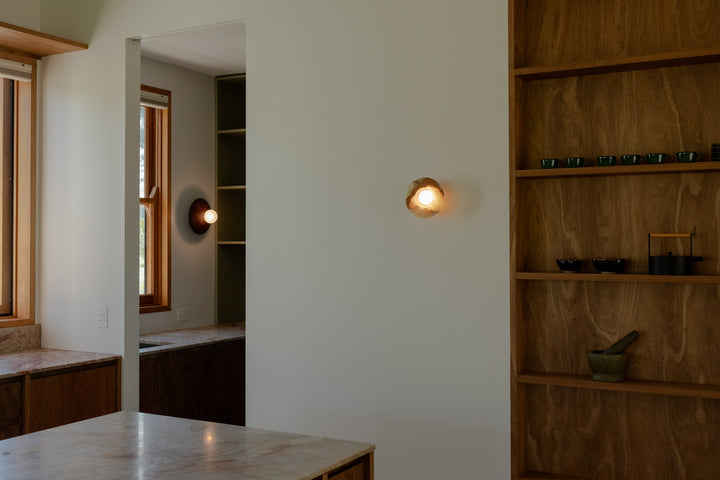With great pride, Marz Designs would like to introduce our extremely talented collaborators Cain and Ash Lambourn of the Sunshine Coast based Formation Glass. Cain and Ash have been instrumental in the development of a few of our designs. We’ve worked with Formation Glass for some time, and are extremely grateful for their expertise and attribute a lot of our unique lighting aesthetic to their workmanship.
These days Cain and Ash make our Lini Pendants, and we’re working with them on a new range of products to be released in 2023 that involves coloured glass.
We recently sat down with Cain to find out more about his practice and passion for glassblowing. Read the full interview below.

Firstly, what is glass blowing? Could you please describe the process?
There are two types of glassblowing, scientific and hot glassblowing. Hot glass is more commonly known and is generally what people associate the process with (picture gathered molten glass on the end of a long blow pipe being pulled from a furnace).
Scientific glassblowing, which is what I am trained in and practice, is a trade which is responsible for manufacturing laboratory glassware. Using a lathe or a bench, glass is rotated in tubular form and manipulated by introduction of heat from a hand torch which is fed by both an LPG and oxygen mix. Through heating parts of the borosilicate glass tube, sections of the glass can be manipulated in localised areas using the aid of breath and carbon tooling to create the desired shape.
“Working with hot glass and the concentration it takes is quite therapeutic. I liken it to the feeling you have sitting at the campfire at night looking into the flame.”
Are you limited by tools and technology in your craft? What are the most technical factors of your work?
As a scientific glassblower in Australia, the industry is isolated from other larger scientific glassblowing communities around the world. In places like Europe and in the US, the trade is practised on a much larger scale. Because of this isolation, we don’t have the most up-to-date equipment or technology available to us. Instead, over many years we have become clever at modifying and adapting our existing equipment to be able to complete glass products at a world class standard (I like to think of myself as the MacGyver of the glassblowing world!).


“I fell into scientific glassblowing through my high school sweetheart Ash (now wife and mother of our two beautiful children. Her dad Steve offered me an apprenticeship in scientific glassblowing when I was 18 and I started working for his business Carlton Glass soon after.”
What do you like most about working with glass?
Working with hot glass and the concentration it takes is quite therapeutic. I liken it to the feeling you have sitting at the campfire at night looking into the flame. I find it relaxing (when the glass isn’t breaking). I also really like the challenge of making something that others may not think possible, and bringing to life my clients’ visions.
What is your favourite type of glass to work with?
I really enjoy working with white borosilicate glass, and it happens to be one of my most popular glasses due to its amazing diffusing ability in lighting. It has taken me many years to get the finish of this glass right as it requires certain techniques and heat levels to keep a consistent beautiful white cloud finish, perfect when transmitting warm light through it.
What does a regular day at the workshop look like?
A day at the workshop generally starts with me pulling material from the glass bays and laying it out on the workshop tables while I plan the process of manufacture for the current project I’m working on. Planning and preparation is an important part of the day as with a lot of glass projects I complete, when working under heat, sometimes I only get one shot to get it right.
From here I like to keep a complete dimensional drawing which my customer has provided near the lathe so I can make sure that once I start the heating and manipulation process I am meeting the specs outlined. There are many individual steps involved in each project with a lot of stop and starting during heating. I’m fortunate being a small family business to have my wife Ashleigh with me in the workshop full time. Ash acts as a support to me while I am working hot, she also takes on many roles in the workshop from sandblasting, quality control and packaging. The days are spent between us coordinating project completion activities so that we can deliver to our customers on time.

“I really like the challenge of making something that others may not think possible, and bringing to life my clients’ visions.”


How did you first get into glass blowing? What was your journey to this point? Were you interested in glass blowing from a young age or did it happen by chance?
I fell into scientific glassblowing through my high school sweetheart Ash (now wife and mother of our two beautiful children. Her dad Steve offered me an apprenticeship in scientific glassblowing when I was 18 and I started working for his business Carlton Glass soon after. Carlton Glass, which still operates today, specialises in the manufacture of precision glass hydrometers and laboratory glassware. I always enjoyed this area of work but admired and appreciated the beauty of scientific glass and felt it had a place in design. So, with that, Formation Glass was born.
What other kinds of glasswork do you do?
Formation Glass specifically services the Australian design industry, the majority of what we make is glass components for lighting designers. We have also assisted designers in the prototype and manufacture of glass homeware products and the architectural industry with glass installations.
“Offering designers in Australia a glass option that is of an international standard is important to me and it brings me so much satisfaction seeing designers I have worked with here in Australia have success on a world stage using glass which has come out of my workshop.”



What are the most important aspects of the end result i.e. stability, form, scale?
This depends on the intended outcome – if it’s a one-off piece or a product line determines some of the most important aspects. For product lines, consistency of the scales, shape and overall look is very important. As scientific glassblowers specialising in precision glassware, we have a great ability to replicate. For one-off pieces, being able to visualise the piece installed in its space is important, as the goal is to always deliver on the designer’s vision.
Who inspires you and what motivates you to keep making?
Lasvit, a designer based in Czech Republic. They’re a world leader in the use of glass in design and their continued commitment to push the boundaries of glass and their amazing projects inspires me to continue to push the boundaries here in Australia. Offering designers in Australia a glass option that is of an international standard is important to me and it brings me so much satisfaction seeing designers I have worked with here in Australia have success on a world stage using glass which has come out of my workshop.







